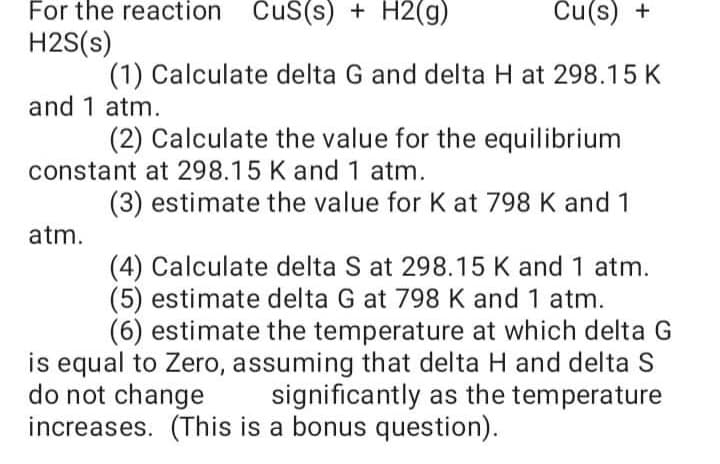For the reaction CuS(s) + H2(g) Cu(s) + H2S(s) (1) Calculate delta G and delta H at 298.15 K and 1 atm. (2) Calculate the value for the equilibrium constant at 298.15 K and 1 atm. (3) estimate the value for K at 798 K and 1 atm.
For the reaction CuS(s) + H2(g) Cu(s) + H2S(s) (1) Calculate delta G and delta H at 298.15 K and 1 atm. (2) Calculate the value for the equilibrium constant at 298.15 K and 1 atm. (3) estimate the value for K at 798 K and 1 atm.
Chemistry
10th Edition
ISBN:9781305957404
Author:Steven S. Zumdahl, Susan A. Zumdahl, Donald J. DeCoste
Publisher:Steven S. Zumdahl, Susan A. Zumdahl, Donald J. DeCoste
Chapter1: Chemical Foundations
Section: Chapter Questions
Problem 1RQ: Define and explain the differences between the following terms. a. law and theory b. theory and...
Related questions
Question
Please help, the second picture are some formula on how to get G and H

Transcribed Image Text:For the reaction CuS(s) + H2(g)
Cu(s) +
H2S(s)
(1) Calculate delta G and delta H at 298.15 K
and 1 atm.
(2) Calculate the value for the equilibrium
constant at 298.15 K and 1 atm.
(3) estimate the value for K at 798 K and 1
atm.
(4) Calculate delta S at 298.15 K and 1 atm.
(5) estimate delta G at 798 K and 1 atm.
(6) estimate the temperature at which delta G
is equal to Zero, assuming that delta H and delta S
significantly as the temperature
do not change
increases. (This is a bonus question).
![07:14
internal
change
work AHr
AS 298
AG
AG
AE
AG=
AE = E2-
AHt = (Enmol px
AS-298 = (Enmolpx
AG = AG 208 +
AHp) - Znmol r x aHrj aspl - Enmol rx AS
AH-
E1
2.303RT logo
PAV
TAS
AE =Q-
E2- El
Q-W
AE +
AEsurr
Changes in enthalpy, entropy, free energy
change
enthalpy AH entropy AS
free energy AG
in
exothermic
decrease in the randomness or
spontaneous; exothermic
negative
value
reaction
disorder of the system
reaction; Keq>1
positive
endothermic
increase in the randomness or
nonspontaneous reaction:
value
reaction
disorder of the system
Work
w (positive or > 0) w (negative or < 0)
https://www.mibigler.com/misclen
ergy-ot-formation.PDE
heat is absorbed
heat is released
energy is
transferred FROM
energy is transterred
FROM the
the system TO the
surroundings TO the
system as work
surroundings as
work
work is done by
the system (ON
the surroundings)
work is done ON the
system
the internal energy the internal energy E
E of the system will of the system will be
be decreased by
increased by the
the amount of work amount of work done
to that system
it does.
Spontaneous or
nonspontaneous
AS
AH (change
spontaneous /
(change in
entropy)
in enthalpy)
nonspontaneous
negative ) posove (+) sportaneous at
all temp
contenmed 2nd quarter notes sans jamtoard]
2 of 10
AS
дн (change
spontaneous/
(change in
II](/v2/_next/image?url=https%3A%2F%2Fcontent.bartleby.com%2Fqna-images%2Fquestion%2F1293fc9f-99b9-4ea9-9a8d-d571e52ca684%2F18b2b9a9-4b85-4365-b3e3-cb3825940436%2F3xi644v_processed.jpeg&w=3840&q=75)
Transcribed Image Text:07:14
internal
change
work AHr
AS 298
AG
AG
AE
AG=
AE = E2-
AHt = (Enmol px
AS-298 = (Enmolpx
AG = AG 208 +
AHp) - Znmol r x aHrj aspl - Enmol rx AS
AH-
E1
2.303RT logo
PAV
TAS
AE =Q-
E2- El
Q-W
AE +
AEsurr
Changes in enthalpy, entropy, free energy
change
enthalpy AH entropy AS
free energy AG
in
exothermic
decrease in the randomness or
spontaneous; exothermic
negative
value
reaction
disorder of the system
reaction; Keq>1
positive
endothermic
increase in the randomness or
nonspontaneous reaction:
value
reaction
disorder of the system
Work
w (positive or > 0) w (negative or < 0)
https://www.mibigler.com/misclen
ergy-ot-formation.PDE
heat is absorbed
heat is released
energy is
transferred FROM
energy is transterred
FROM the
the system TO the
surroundings TO the
system as work
surroundings as
work
work is done by
the system (ON
the surroundings)
work is done ON the
system
the internal energy the internal energy E
E of the system will of the system will be
be decreased by
increased by the
the amount of work amount of work done
to that system
it does.
Spontaneous or
nonspontaneous
AS
AH (change
spontaneous /
(change in
entropy)
in enthalpy)
nonspontaneous
negative ) posove (+) sportaneous at
all temp
contenmed 2nd quarter notes sans jamtoard]
2 of 10
AS
дн (change
spontaneous/
(change in
II
Expert Solution
This question has been solved!
Explore an expertly crafted, step-by-step solution for a thorough understanding of key concepts.
This is a popular solution!
Trending now
This is a popular solution!
Step by step
Solved in 3 steps with 3 images

Knowledge Booster
Learn more about
Need a deep-dive on the concept behind this application? Look no further. Learn more about this topic, chemistry and related others by exploring similar questions and additional content below.Recommended textbooks for you

Chemistry
Chemistry
ISBN:
9781305957404
Author:
Steven S. Zumdahl, Susan A. Zumdahl, Donald J. DeCoste
Publisher:
Cengage Learning

Chemistry
Chemistry
ISBN:
9781259911156
Author:
Raymond Chang Dr., Jason Overby Professor
Publisher:
McGraw-Hill Education

Principles of Instrumental Analysis
Chemistry
ISBN:
9781305577213
Author:
Douglas A. Skoog, F. James Holler, Stanley R. Crouch
Publisher:
Cengage Learning

Chemistry
Chemistry
ISBN:
9781305957404
Author:
Steven S. Zumdahl, Susan A. Zumdahl, Donald J. DeCoste
Publisher:
Cengage Learning

Chemistry
Chemistry
ISBN:
9781259911156
Author:
Raymond Chang Dr., Jason Overby Professor
Publisher:
McGraw-Hill Education

Principles of Instrumental Analysis
Chemistry
ISBN:
9781305577213
Author:
Douglas A. Skoog, F. James Holler, Stanley R. Crouch
Publisher:
Cengage Learning

Organic Chemistry
Chemistry
ISBN:
9780078021558
Author:
Janice Gorzynski Smith Dr.
Publisher:
McGraw-Hill Education

Chemistry: Principles and Reactions
Chemistry
ISBN:
9781305079373
Author:
William L. Masterton, Cecile N. Hurley
Publisher:
Cengage Learning

Elementary Principles of Chemical Processes, Bind…
Chemistry
ISBN:
9781118431221
Author:
Richard M. Felder, Ronald W. Rousseau, Lisa G. Bullard
Publisher:
WILEY